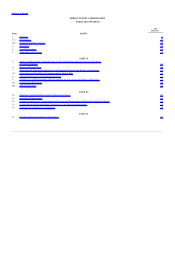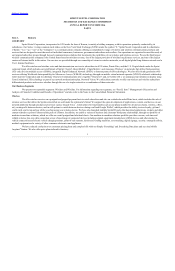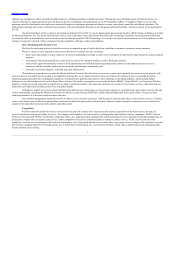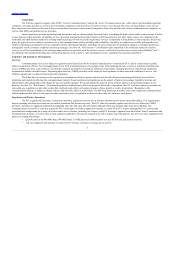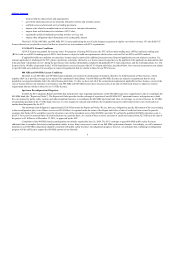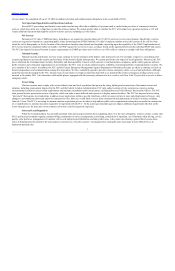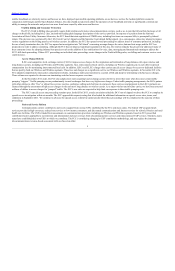Sprint - Nextel 2011 Annual Report Download - page 6
Download and view the complete annual report
Please find page 6 of the 2011 Sprint - Nextel annual report below. You can navigate through the pages in the report by either clicking on the pages listed below, or by using the keyword search tool below to find specific information within the annual report.
Table of Contents
Additionally, AT&T, T-Mobile and Verizon also offer competitive prepaid services and wholesale services to resellers. Competition will increase to the extent that new
firms enter the market as a result of the introduction of other technologies such as LTE, the availability of previously unavailable spectrum bands, such as the 700 MHz
spectrum band and the potential introduction of new services using unlicensed spectrum. Wholesale services and products also contribute to increased competition. In
some instances, resellers that use our network and offer like services compete against our offerings.
Most markets in which we operate have high rates of penetration for wireless services, thereby limiting the growth of subscribers of wireless services. As the
wireless market has matured, it has become increasingly important to retain existing subscribers in addition to attracting new subscribers, particularly in less saturated
growth markets such as those with non-traditional data demands. Wireless carriers are addressing the growth in non-traditional data needs by working with OEMs to
develop connected devices such as after-market in-vehicle connectivity and electric vehicle charging stations, point-of-sale systems, kiosks and vending machines, asset
tracking, digital signage, security, smartgrid utilities, medical equipment and a variety of other consumer electronics and appliances, which utilize wireless networks to
increase consumer and business mobility. In addition, we and our competitors continue to offer more service plans that combine voice and data offerings, plans that allow
users to add additional mobile devices to their plans at attractive rates, plans with a higher number of bundled minutes included in the fixed monthly charge for the plan,
plans that offer the ability to share minutes among a group of related subscribers, or combinations of these features. Consumers respond to these plans by migrating to
those they deem most attractive. In addition, wireless carriers also try to appeal to subscribers by offering devices at prices lower than their acquisition cost. We may offer
higher cost devices at greater discounts than our competitors, with the expectation that the loss incurred on the cost of the device will be offset by future service revenue.
As a result, we and our competitors recognize point-of-sale losses that are not expected to be recovered until future periods when services are provided. Our ability to
effectively compete in the wireless business is dependent upon our ability to retain existing and attract new subscribers in an increasingly competitive marketplace. See
Item 1A, “Risk Factors—If we are not able to retain and attract wireless subscribers, our financial performance will be impaired.”
Wireline
We provide a broad suite of wireline voice and data communications services to other communications companies and targeted business and consumer
subscribers. In addition, we provide voice, data and IP communication services to our Wireless segment, and IP and other services to cable Multiple System Operators
(MSOs). Cable MSOs resell our local and long distance services and use our back office systems and network assets in support of their telephone service provided over
cable facilities primarily to residential end-user subscribers. We are one of the nation's largest providers of long distance services and operate all-digital global long
distance and Tier 1 IP networks.
Services and Products
Our services and products include domestic and international data communications using various protocols such as multiprotocol label switching technologies
(MPLS), IP, managed network services, Voice over Internet Protocol (VoIP), Session Initiated Protocol (SIP) and traditional voice services. Our IP services can also be
combined with wireless services. Such services include our Sprint Mobile Integration service, which enables a wireless handset to operate as part of a subscriber's wireline
voice network, and our DataLinkSM service, which uses our wireless networks to connect a subscriber location into their primarily wireline wide-area IP/MPLS data
network, making it easy for businesses to adapt their network to changing business requirements. In addition to providing services to our business customers, the wireline
network is carrying increasing amounts of voice and data traffic for our Wireless segment as a result of growing usage by our wireless subscribers.
We continue to assess the portfolio of services provided by our Wireline business and are focusing our efforts on IP-based services and de-emphasizing stand-
alone voice services and non-IP-based data services. We also provide wholesale voice local and long distance services to cable MSOs, which they offer as part of their
b
undled service offerings, as well as traditional voice and data services for their enterprise use. However, the digital voice services we provide to some of our cable MSOs
have become large enough in scale that they have decided to in-source these services. We also continue to provide voice services to residential consumers. Our Wireline
segment markets and sells its services primarily through direct sales representatives.
4


